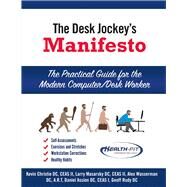The Desk Jockey's Manifesto- Sc-Color Interior Printing The Practical Guide for the Computer/Desk Worker
, by CEAS, Kevin Christie DC; CEAS, Larry Masarsky DC; ART, Alex Wasserman DC; CEAS, Daniel Assion DC; ART, Geoff Rudy DC- ISBN: 9781483578743 | 1483578747
- Cover: Paperback
- Copyright: 9/26/2016
Our goal with this guide is to give you a clear understanding of your body, the effects of sitting, how to properly set-up your workstation, self-assessments, and how to prevent the de-conditioned syndrome through exercises and stretches. We don’t intend to make you fearful of the effects of sitting, but rather understand and integrate easy-to-do solutions for your body and your workstation that will prevent the musculoskeletal pain and injuries. This guide will be your road map to a superior lifestyle and your guide to correcting your way of life in your workstation.
What is Ergonomics?
The word ‘ergonomics’ comes from the Greek words ‘ergon’ which means work, and ‘nomos’ which means natural laws. Ergonomics can thus be defined simply as the natural laws of work. More specifically, ergonomics is the scientific study of designing the job and workplace to fit the worker, keeping in mind their capabilities and limitations. Ergonomics combines the knowledge from other scientific disciplines like anatomy and physiology, biomechanics, engineering, psychology, and statistics to ensure that workplace designs complement the strengths of people and minimize the effects of their limitations.
Ergonomics is also known as human factors, and the terms are often used interchangeably. Ergonomists and human factors specialists seek to understand how a workplace, product, tool, or system can be best designed to fit the people who need to use it. The goal is to apply this knowledge to improve the system, human performance, and productivity, while also focusing on the health, safety, and well-being of the individuals involved.
Why is Ergonomics Important?
Think about how many hours each day you spend sitting. If you work in an office setting, you are likely sitting more than most people. According to Occupational Safety and Health Administration (OSHA) statistics, on average, 95% of an office worker’s day is spent sitting in front of the computer.
Sitting in front of a computer all day for work is a relatively new concept that has become more common over the past two decades. Consequently, the adverse health effects associated with prolonged sitting have become more prevalent and are exacerbated when working at a computer. This is often due to poorly designed computer workstations and the physical stress that it places on joints, muscles, tendons, and nerves of the body.
The High Cost of MSDs
OSHA has identified that Work-Related MSDs are the single largest job-related injury and illness problem in the US and account for 34% of all reported lost workday illnesses and injuries, with over 600,000 MSDs requiring time away from work every year. Carpal tunnel syndrome is the single most common injury in the workplace, accounting for 15% of all workplace injuries, and 42% of carpal tunnel syndrome cases result in more than 30 days absence from work. MSDs now account for 1 out of every 3 dollars spent on worker’s compensation and employers spend $15-$20 billion a year on direct costs for MSD-related workers' compensation, and up to five times that much for indirect costs.







